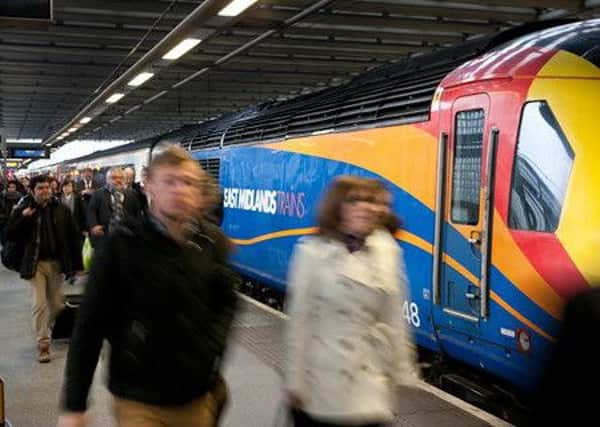Call for investment in ‘decrepit’ rail rolling stock


The average age of trains is 20.2 years across the country and is even older outside the South East, according to data from the Office of Rail and Road (ORR).
Rolling stock is at its oldest level since 2001 when the average age was 20.3 years, analysis by the Press Association shows.
Advertisement
Hide AdAdvertisement
Hide AdThe Rail Delivery Group (RDG), which represents train operators and Network Rail, said thousands of new carriages will be introduced in the next few years.
The latest ORR statistics show that average rolling stock in London and the South East is 18.1 years old. The figure for the rest of the country is 22.6 years, the highest since current records began in April 2000.
Merseyrail has the oldest trains of any operator, averaging 36.3 years.
Average age of rolling stock used by each train operating company in Britain, ranked from oldest to newest (figures for January-March 2015):
1. Merseyrail: 36.3 years
2. First Great Western: 32.4 years
3. Virgin Trains East Coast: 29.3 years
4. Govia Thameslink Railway: 28.9 years
5. Greater Anglia: 27.6 years
6. Northern Rail: 26.3 years
7. Arriva Trains Wales: 24.4 years
8. East Midlands Trains: 23.3 years
9. ScotRail: 20.5 years
10. Chiltern: 19.1 years
11. South West Trains: 18.9 years
12. CrossCountry: 16.6 years
13. Southeastern: 15.4 years
14. c2c: 14.0 years
15. Southern: 13.9 years
16. London Midland: 11.0 years
17. Virgin Trains West Coast: 10.4 years
18. First TransPennine Express: 7.7 years
19. London Overground: 4.7 years
====
Advertisement
Hide AdAdvertisement
Hide AdEd Cox, director at think tank IPPR (Institute for Public Policy Research) North, said : “ Some of the North’s outdated train rolling stock could be considered more of a laughing stock, with carriages and overcrowding not fit for purpose for a burgeoning northern economy.
“Decades of chronic underinvestment in the North’s transport infrastructure has held back the region, with commuters and business frustrated by the poor service on offer.”
Passenger groups called for a new strategy to improve trains across the country.
Martin Abrams of the Campaign for Better Transport said: “These figures are not particularly surprising as we know thousands of passengers are travelling on trains simply not fit for purpose.
Advertisement
Hide AdAdvertisement
Hide Ad“In the North of England, for instance, passengers are still having to endure the decrepit old Pacer trains.
“The problem is there’s no national rolling stock strategy from the Government and that’s what needs to change.
“The Government needs to come up with a plan to replace outdated rolling stock and ensure passengers have trains fit for the 21st century.”
A spokesman for independent watchdog Transport Focus said modern trains were “urgently needed” in some areas.
Advertisement
Hide AdAdvertisement
Hide AdBruce Williamson, of campaign group Rail Future, said: “ We need a very long-term, steady stream of investment, without the stop-start feast or famine we’ve seen in the past decades which isn’t good for the rail industry.”
He added: “ We have a desperate shortage of rail stock across the network so we can’t afford to get rid of any of it.”
Trade unions urged the Government to “get a grip” on reducing the age of rolling stock.
Mick Cash, general secretary of the Rail, Maritime and Transport union, said: “The lack of planning on Britain’s fragmented and privatised railways has left growing numbers of passengers travelling in clapped-out, overcrowded trains while the rip-off rail companies are laughing all the way to the bank.”
Advertisement
Hide AdAdvertisement
Hide AdTransport Salaried Staffs Association leader Manuel Cortes said: “Passengers deserve so much better from the rail companies than to be shunted around in old, outdated and uncomfortable carriages.
“This Government should get a grip and start investing in a railway and rolling stock fit for this century not the last one.”
Mick Whelan, general secretary of Aslef, the train drivers’ union, claimed “the failure to introduce enough modern trains that treat the travelling public better than cattle” was one of the major failings of privatisation of the network.
He added: “ Those passengers in the regions will always be disadvantaged by the cascading system of newer trains for the South East and intercity services, and hand-me-downs for everyone else.”
Advertisement
Hide AdAdvertisement
Hide AdThe RDG insisted the private sector has invested billions of pounds in new trains over the past 20 years.
The organisation said that trains which have already been ordered will reduce the average age of the national fleet.
A spokesman said: “Train companies work closely with the Department for Transport (DfT) to buy new rolling stock. In the next few years, thousands of new carriages will be introduced with more seats, giving passengers faster and more comfortable journeys.”
The DfT claimed it was committed to introducing modern trains and called on the rail industry to “come up with further innovative proposals” to improve rolling stock.
Advertisement
Hide AdAdvertisement
Hide AdA spokesman said: “ We’re already making massive improvements through franchising - such as removing Pacer trains from the North of England and introducing new state-of-the-art trains on the East Coast, Great Western and Thameslink lines.
“By the end of 2019 there will be more than 3,700 extra carriages on the network compared to 2010.”
The latest figures released by the ORR show the average age of rolling stock between January and March.
Long distance stock is an average of 23.7 years old.